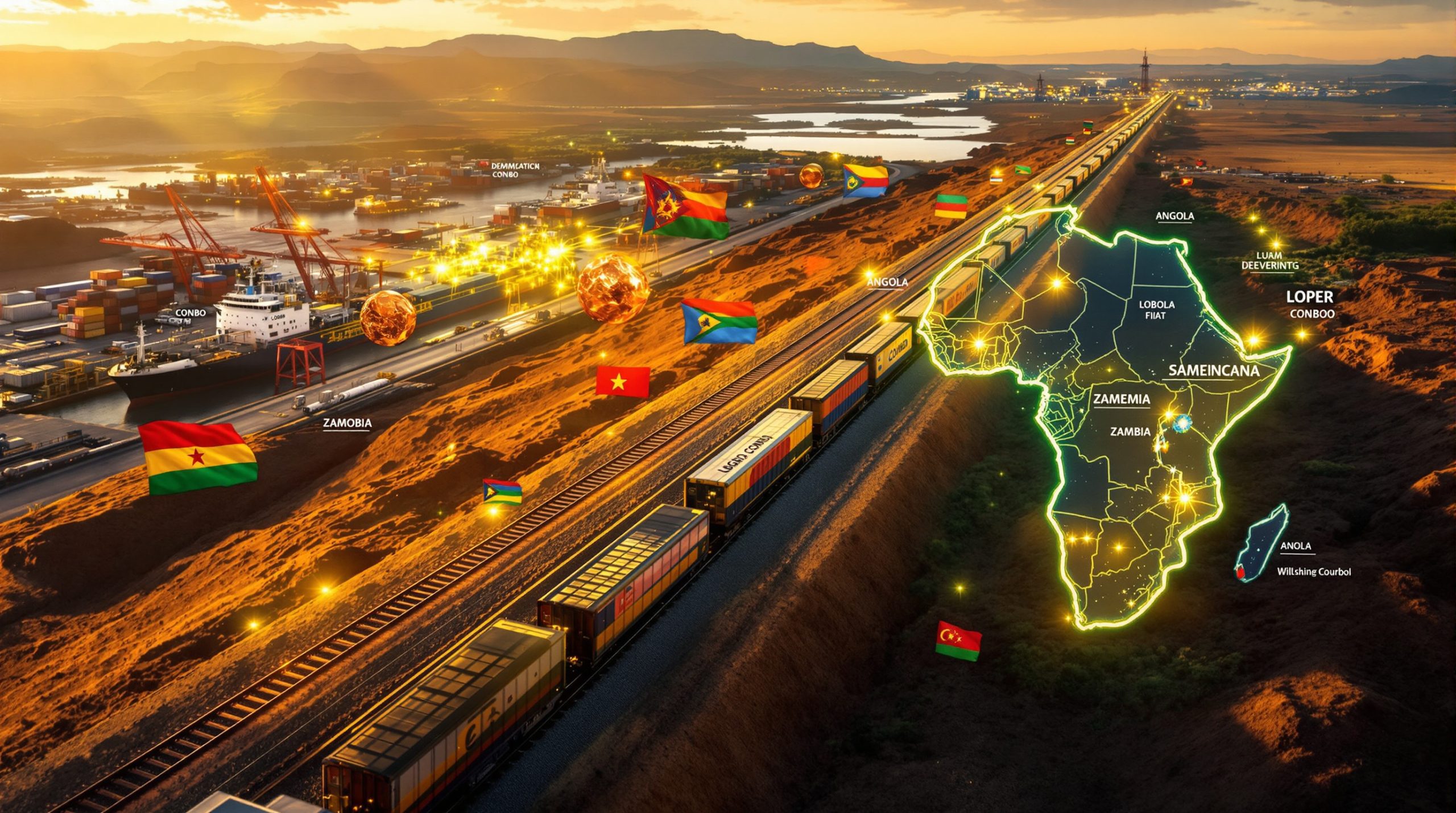DRC Cobalt Export Quotas: A Strategic Pivot with Global Implications
The Democratic Republic of Congo (DRC) is fundamentally transforming its approach to cobalt exports, moving from a complete ban to a structured quota system beginning October 16, 2025. This policy shift represents a calibrated strategy to maintain the country's dominant position in the global cobalt market while addressing price instability that has plagued the sector since early 2023.
The strategic importance of this policy change extends far beyond the DRC's borders, impacting global supply chains, battery manufacturing, and the broader clean energy transition. With approximately 70% of global cobalt production originating from the DRC, the implementation of DRC cobalt export quotas will reshape market dynamics for years to come.
How is the DRC Transforming its Cobalt Export Policy?
The DRC is implementing a carefully structured export quota system to replace the complete ban that has been in place since February 2023. This new framework aims to balance market stabilization with continued supply to global industries dependent on cobalt for battery metals investment and other technological applications.
The quota system introduces predictability to the market while allowing the DRC to maintain significant control over its most strategic mineral resource. By establishing specific export allowances through 2027, the country is signaling a long-term commitment to managed supply rather than market-driven exports.
Timeline and Quota Allocation Structure
The quota system follows a precise schedule with different allowances based on time periods:
- Remainder of 2025: 18,125 tonnes permitted for export after October 16
- 2026-2027: Annual quotas of 96,600 tonnes for each year
- Monthly controls: Export volumes will be monitored and regulated on a monthly basis
- October 2025 specific limit: 3,625 tonnes maximum due to mid-month implementation
This graduated approach allows for a controlled return of Congolese cobalt to international markets, preventing a sudden flood that could destabilize prices while ensuring sufficient supply to meet global demand.
Regulatory Oversight and Strategic Reserves
The Authority for the Regulation and Control of Strategic Mineral Substances' Markets (ARECOMS) will serve as the primary regulatory body overseeing the implementation of the quota system. Their responsibilities include:
- Determining quota allocations based on companies' historical export volumes
- Managing approximately 87,000 tonnes allocated proportionally to producers
- Retaining around 9,600 tonnes under discretionary control
- Reserving 10% of export volumes for national strategic projects
- Exercising authority to repurchase excess cobalt stocks that exceed quarterly company quotas
This regulatory structure gives the DRC government significant leverage in managing both domestic production and global market dynamics, while creating mechanisms to ensure compliance with the quota limits.
Why Did the DRC Implement Cobalt Export Restrictions?
The DRC's transition to export quotas comes after a complete export ban imposed in February 2023 and subsequently extended in June 2025. This restrictive approach emerged in response to several critical challenges that threatened both the country's economic interests and the stability of global cobalt markets.
Market Stabilization and Price Support
The primary trigger for export restrictions was the dramatic decline in cobalt prices that occurred in early 2023:
- Cobalt prices plummeted to nine-year lows, undermining the economic viability of production
- Market oversupply created unsustainable price depression across the sector
- The DRC government recognized the need to protect revenue streams from its most strategic mineral resource
- Without intervention, continued price erosion threatened both industrial and artisanal mining operations
By restricting exports, the DRC government aimed to reduce global supply and create conditions for price recovery, protecting not only its mining sector but also its broader economic interests.
Addressing Unregulated Mining and Regional Conflict
Beyond market stabilization, the export policy shift addresses significant governance challenges within the DRC's mining sector:
- Widespread unregulated artisanal mining operations have created environmental and social challenges
- Traceability and compliance issues have complicated international buyer relationships
- The government has linked illegal mining activities to violence involving M23 rebels in eastern Congo
- Export restrictions create leverage to improve oversight and formalization of the mining sector
By controlling exports through quotas, the DRC aims to improve governance within the sector while addressing some of the root causes of regional instability linked to unregulated resource extraction.
What is the Global Significance of DRC's Cobalt Production?
The DRC's dominance in global cobalt production makes its export policies particularly consequential for technology markets and clean energy transitions worldwide.
Market Dominance and Supply Chain Implications
The DRC's position in the global mining landscape is unparalleled and creates significant leverage:
- Accounting for approximately 70% of global cobalt production, the DRC serves as the primary source for battery manufacturers worldwide
- The country represents a critical link in technology supply chains that power electric vehicles, energy storage systems, and consumer electronics
- DRC production volumes directly influence global price trends and availability
- Any disruption to DRC supply creates immediate ripple effects throughout downstream industries
This market position gives the DRC significant influence over global technological development, particularly as demand for battery materials continues to grow with the expansion of electric vehicle production.
Key Production Statistics and Market Share
The DRC's cobalt sector features a mix of industrial and artisanal production:
- Major multinational mining companies including Glencore and CMOC Group operate large-scale operations
- Significant artisanal mining operations contribute to overall production volumes
- Geological reserves are sufficient to maintain the DRC's dominance for decades to come
- Growing downstream processing capacity aims to capture additional value from mineral resources
This production landscape creates both opportunities and challenges for implementing a quota-based system, as the regulatory framework must account for both large industrial producers and smaller-scale operations.
How Have Major Mining Companies Responded to the Export Policy?
The shift from an outright ban to a quota system has elicited varied responses from the major cobalt producers operating in the DRC, reflecting their different market positions and strategic interests.
Glencore's Strategic Positioning
Glencore, one of the world's largest cobalt producers, has demonstrated a generally supportive stance toward the quota system:
- The company has advocated for stable pricing before lifting the export ban
- Its position aligns with the DRC government on the need to manage oversupply
- As a diversified global mining company, Glencore potentially benefits from market stabilization even with restricted export volumes
- The company is simultaneously exploring the potential sale of its majority stake in Kamoto Copper Company (KCC), a major copper-cobalt operation in the DRC
These positions reflect Glencore's global portfolio approach, where stable pricing may outweigh maximum production volumes from any single operation.
CMOC Group's Opposition and Concerns
China-based CMOC Group has taken a contrasting position on export restrictions:
- The company requested the complete lifting of the cobalt export ban in May 2025
- It has expressed opposition to the quota system, preferring market-determined export volumes
- CMOC declared force majeure during the ban period, signaling significant operational impacts
- The company potentially faces greater financial impact due to its significant DRC production capacity and focus on cobalt
These divergent corporate positions highlight the complex interests at play in the DRC's cobalt sector, where different companies have varying exposures to price volatility and production restrictions.
What Market Effects Are Anticipated from the Quota System?
The implementation of DRC cobalt export quotas is expected to have substantial impacts on global cobalt markets, affecting everything from price trends to supply chain planning and investment decisions.
Supply-Demand Balance Projections
Market analysts anticipate significant shifts in the cobalt supply-demand equation:
- A potential transition from market surplus to deficit could emerge by 2026-2027 as quotas restrict global supply
- Tightening availability will likely impact buyers with longer lead times for securing material
- A typical three-month shipping timeline for DRC material to reach major markets like China will complicate planning
- Manufacturers may need to draw down existing inventories as they adjust to new supply realities
These dynamics could create uneven impacts across different end-use sectors, with larger buyers potentially better positioned to secure long-term supply agreements under the quota system.
Price Trajectory and Market Stabilization
The quota system is likely to influence cobalt pricing in several ways:
- Market analysts project potential price recovery toward historical levels above $20 per pound
- More predictable supply patterns should enable better market forecasting and reduce speculation
- Reduced price volatility through controlled export volumes benefits both producers and consumers
- Premium pricing may emerge for guaranteed supply contracts in a quota-constrained environment
The price stabilization effects could benefit the entire supply chain by creating more predictable conditions for investment and planning, though at potentially higher average prices than during the oversupply period.
How Does the Quota System Affect Global Battery Supply Chains?
As a critical component in lithium-ion batteries, cobalt's availability directly impacts the electric vehicle revolution and energy storage systems worldwide.
Electric Vehicle Manufacturing Implications
The restricted cobalt supply could influence EV production strategies in several ways:
- Potential acceleration of battery chemistry innovations to reduce cobalt dependency
- Supply chain diversification efforts by manufacturers seeking to reduce reliance on DRC material
- Possible price increases for cobalt-containing batteries, particularly for NMC (nickel-manganese-cobalt) chemistries
- Strategic stockpiling by major battery producers to ensure production continuity
These responses will vary based on manufacturers' existing supply agreements, technological flexibility, and market positioning, with some potentially better positioned to adapt than others.
Regional Processing and Value Addition
The quota system may accelerate trends toward local processing within the DRC:
- Economic incentives for in-country refining to maximize value capture before export
- Potential exemptions or preferential treatment for processed materials versus raw ore exports
- Shifting dynamics between raw material exports and refined product exports
- New investment opportunities in DRC processing facilities to secure access to material
These trends align with broader resource nationalism movements globally, where producer countries increasingly seek to capture more value from their natural resources through domestic processing.
What Regulatory Complexities Does the Quota System Introduce?
The transition to a quota-based system creates new administrative and compliance challenges for companies operating in the DRC's cobalt sector.
Quota Allocation Mechanisms and Compliance Requirements
Companies must navigate a more complex regulatory environment:
- Historical export volumes serve as the primary basis for determining future quota allocations
- Companies face potential quarterly adjustments based on market conditions and compliance
- New compliance fees and administrative costs may impact operational economics
- Enhanced reporting requirements demonstrate adherence to quota limits
This regulatory framework creates both challenges and opportunities for different market participants, with established producers potentially having advantages in securing larger quota allocations.
Potential Adjustments and Flexibility Provisions
The quota system includes mechanisms for adaptation:
- Provisions for adjustments based on evolving market conditions
- Potential modifications linked to advancements in local refining capabilities
- Discretionary allocation of the reserved 10% for strategic projects provides policy flexibility
- ARECOMS authority to intervene through stock repurchases creates a market stabilization mechanism
These flexibility provisions acknowledge the dynamic nature of global cobalt markets while maintaining the core structure of controlled exports.
What Are the Long-Term Strategic Implications for Global Mineral Security?
The DRC's move toward managed cobalt exports reflects broader trends in resource nationalism and critical minerals strategic reserve development that are reshaping global supply chains.
Resource Nationalism and Supply Chain Resilience
The quota system exemplifies growing trends toward:
- Producer countries exerting greater control over strategic resources through policy instruments
- Shift from pure market dynamics to managed supply approaches for critical minerals
- Increasing focus on domestic value addition in resource-rich nations
- Potential for similar approaches with other critical minerals energy security considerations in various jurisdictions
These trends are forcing consuming countries to reconsider supply chain resilience and security of access for materials deemed critical to industrial and technological development.
Geopolitical Dimensions and International Relations
The DRC's cobalt policy has significant geopolitical implications:
- China-DRC relations are particularly affected given China's dominant position in cobalt processing
- Western concerns about critical mineral access for clean energy transitions may intensify
- International pressure regarding transparency and governance in the DRC mining sector continues
- Regional stability in Central Africa remains linked to resource management
These geopolitical dimensions highlight how mineral policy increasingly intersects with broader international relations and security concerns.
How Might Artisanal Mining Be Affected by Export Quotas?
The large unregulated artisanal mining sector presents unique challenges and opportunities within the new quota framework.
Formalization Efforts and Traceability Challenges
The quota system could accelerate efforts to address artisanal mining issues:
- Improved tracking and traceability systems may become necessary to qualify production for export
- Economic incentives for formalization of artisanal operations could increase
- Challenges in integrating artisanal production into quota allocations remain significant
- Non-compliant sources may face exclusion from export allowances
These dynamics could either accelerate positive formalization of artisanal mining or potentially marginalize smaller producers unable to meet compliance requirements.
Social and Environmental Governance Considerations
The policy shift raises important sustainability questions:
- Impacts on livelihoods dependent on informal mining require careful consideration
- Environmental compliance requirements may increasingly become tied to quota eligibility
- Human rights due diligence expectations from international buyers continue to increase
- Community development initiatives linked to formal production could expand
Addressing these social and environmental dimensions will be critical to the long-term sustainability and legitimacy of the DRC's cobalt sector under the quota system.
What Alternatives Are Emerging to DRC Cobalt Dependence?
The DRC's export controls are accelerating global efforts to reduce reliance on Congolese cobalt through various technological and supply chain innovations.
Battery Chemistry Innovations and Cobalt Reduction
Technology developers are pursuing multiple pathways to reduce cobalt dependency:
- Development of low-cobalt and cobalt-free battery chemistries, including LFP (lithium iron phosphate)
- Research focused on increasing energy density to reduce material requirements per kWh
- Expanded recycling initiatives to recover cobalt from spent batteries
- Alternative energy storage technologies with different material requirements
These technological approaches offer medium to long-term pathways to reduce dependence, though many face challenges in matching the performance characteristics of cobalt-containing batteries.
Geographic Diversification of Cobalt Sourcing
Efforts to develop alternative cobalt sources include:
- Exploration and development projects in Australia, including the Halls Creek cobalt expansion initiatives
- Mining development in Canada, and Indonesia
- Deep-sea mining proposals targeting cobalt-rich nodules on ocean floors
- Reactivation of dormant cobalt mines in response to supply concerns
- Investment in processing technologies for lower-grade deposits previously considered uneconomic
These diversification efforts face significant challenges in scaling to match DRC production volumes, but collectively represent strategic hedges against overreliance on a single source.
Frequently Asked Questions About DRC Cobalt Export Quotas
When will the DRC's new cobalt export quota system begin?
The quota system will commence on October 16, 2025, replacing the complete export ban that has been in place since February 2023. This marks a significant shift in the DRC's approach to managing its cobalt resources.
How much cobalt will the DRC allow to be exported?
For the remainder of 2025, exports will be limited to 18,125 tonnes. For both 2026 and 2027, annual quotas of 96,600 tonnes will apply. These volumes represent a controlled return to the market designed to prevent price collapse while ensuring continued supply.
Who determines how quotas are allocated to different companies?
The Authority for the Regulation and Control of Strategic Mineral Substances' Markets (ARECOMS) will oversee quota allocation, primarily based on historical export volumes. This regulatory body will have significant discretion in managing both the overall quota system and specific company allocations.
Will the quota system affect cobalt prices?
Market analysts anticipate the quotas will tighten cobalt availability, potentially shifting the market from surplus to deficit and driving prices upward toward historical levels above $20 per pound. This price effect is a primary objective of the policy, aimed at supporting both the mining industry and government revenues.
How does the quota system address illegal mining concerns?
The system aims to improve oversight of cobalt exports, potentially reducing illegal mining by ensuring that only properly documented material can be exported within the quota limits. This increased regulatory scrutiny creates economic incentives for formalization and compliance with legal requirements.
Disclaimer: The cobalt market is subject to significant volatility and regulatory changes. Predictions about price movements and market impacts represent analysis based on current information and should not be considered investment advice. Regulatory frameworks continue to evolve, and implementation details may differ from announced policy changes.
Want to Stay Ahead of Major Mineral Discoveries?
Discover significant mineral findings on the ASX before the broader market with Discovery Alert's proprietary Discovery IQ model, delivering real-time notifications on potentially lucrative investment opportunities. Explore historic returns from major discoveries at the Discovery Alert discoveries page and position yourself for tomorrow's market-moving announcements.




